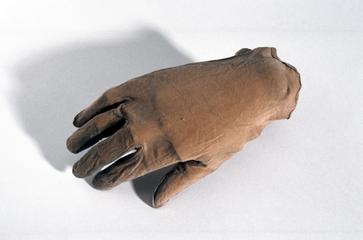
Pair of silk inner gloves used on the 1933 Everest expedition
1930-1933

Equipment used on the 1933 Everest expedition by Sir Jack Longland, including pair silk inner gloves, pair overmitts and pair sheepskin boots by Morland and Co., Glastonbury, Tibetan fur-cap as used by sherpas and muleteers, pair special lightweight double clinker nailed climbing boots (marked R Lawries and Co.), windproof overall suit, and two Shetland wool lightweight sweaters
This clothing was used by Sir Jack Longland, during an unsuccessful attempt to climb Everest in 1933.
Mount Everest (8,849m or 29,032ft), known as Chomolungma in Tibetan or Sagarmatha in Sanskrit, is the tallest mountain in the world. It is considered sacred by the people indigenous to the area and historically was not seen by them as something to be climbed or conquered. In contrast, Between the First World War and the Second World War, there were several attempts by British climbing teams to become the first to climb Mount Everest. This ambition was seen as a way to enhance Britain’s prestige and global standing, as British expeditions had failed to reach the North or South Pole first. It also served strategic goals such as mapping and reconnaissance for the British colonial government in India.
None of the pre-World War Two expeditions made it to the summit of Everest. Mount Everest is a punishing environment, and equipment used by climbers was and still is critical. Expeditions to Everest also relied on vast amounts of indigenous knowledge and labour, which was often not fully acknowledged.
Sir Jack Longland was an important member of the climbing team and is most well-known for a dramatic descent in a storm from Camp 6 (altitude 8,351m or 27,400ft) to Camp 5 (altitude 7,833m or 25,700ft). Longland was one of the climbers helping to build and stock the high-altitude camps in preparation for the summit attempts. On 29 May, a team set off to establish Camp 6, which was placed higher than had ever been attempted before. Longland was leading a team back to Camp 5 when he realised that it would be unsafe for the exhausted group to climb back down the steep slopes they had previously climbed up. Instead, Longland led them along a ridge, on a route he had never taken before, which was made even more challenging when the weather suddenly deteriorated. After descending for hours in terrible weather conditions with very poor visibility, Longland and the team reached the safety of Camp 5. Despite the very poor conditions, they all made it down and none had serious frostbite or other injuries. During their descent, the group had counted each other every few minutes to make sure no one had been left behind, lost or injured.
Camp 6 was the final staging post for the two summit attempts made on the 1933 expedition. Neither attempt was successful, and the early arrival of the monsoon snow meant no further attempts could be made in 1933. It was not for another twenty years, in 1953 when Edmund Hillary and Tenzing Norgay successfully reached the summit of Mount Everest. Everest has since become increasingly popular to climb, raising concerns about increased risk, commercialisation and environmental damage.

1930-1933
1930-1933
1923-1933
1930-1933
1930-1933
1930-1933
1930-1933
1930-1933
1930-1933